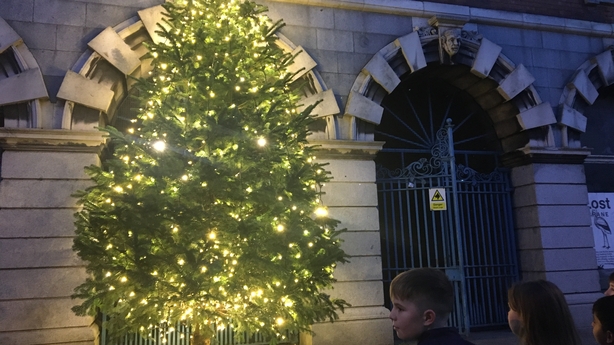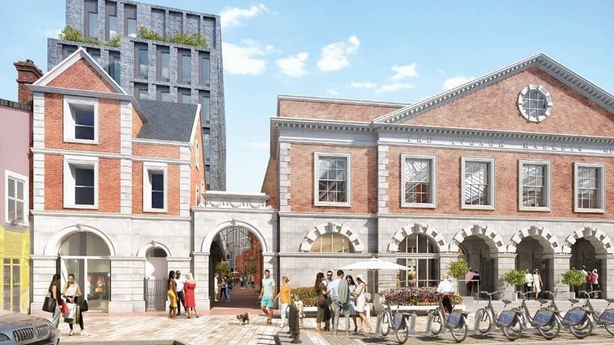A Christmas tree presented by Lord Iveagh has been erected outside the Iveagh Markets following the building's repossession earlier this month.
Lord Iveagh Arthur Guinness arranged the event as the start of a process to restore the market for the people of Dublin, according to a group acting for him in Ireland.
Kevin McGowan, founder of Abbey Life and former partner in Goodbody Stockbrokers, is the executive chairman of the group, while Paul Smithwick of the Smithwick brewing family will be handling the legal issues.
The ceremony revives a tradition, as a Christmas tree was erected on the same spot outside the market every year up until the 1980s when the market was in operation.

Meanwhile, Lord Iveagh has made a series of complaints over the deterioration of the building to several bodies, including Dublin City Council and the Environmental Protection Agency.
The building, which is a protected structure, was repossessed on behalf of Lord Iveagh in the early hours of 8 December.
Businessman Martin Keane had been in possession and first purchased an interest in the site from Dublin City Council for nearly €2m in 1998.
However, his planned 'Covent Garden' style development involving a food market, hotels and restaurants failed to materialise and the building has been lying empty ever since.
A report compiled following visits by conservation and design experts on behalf of Lord Iveagh, including designer Diarmuid Gavin, raised concern about the state of the building.
It found that the roof and rainwater drainage system were in a "very poor condition" and added "a purely conservational approach to retain the current condition is not sufficient any longer but requires a restoration approach to the main elements".
It also found that further deterioration has occurred since a Dublin City Council report in 2018 expressed concern about the state of the building, estimating it would cost €13m in repairs and €30m to restore.
A number of drums of used cooking oil were found inside the building during the visits to the Edwardian market building, which the report stated it was "full of rubbish".

A national monument involving remains of ancient ditches along the original city walls dating back to Norman and possibly Viking times that were filled in the 15th Century have been left exposed, it stated.
It found that works had created openings in walls that had caused "irrevocable damage".
Floor slabs had been removed, which had a detrimental effect on the building's stability, while red bricks had been removed and windows broken out.
While Mr Keane had planning permission to develop the building, the report said there was no evidence of commencement notices being issued.
Lawyers acting for Lord Iveagh have written the Environmental Protection Agency, the National Monuments Service, the Dublin City Archaeologist, the Health and Safety Authority and Dublin City Council's Planning Enforcement asking them to investigate possible regulation breaches.

Mr Keane has defended his handling of the property and said all works carried out, including archaeological works, been done in accordance with planning permission and "with great care".
He also said that everything was done under the "constant supervision of Dublin City Council at all times".
The building was in a dangerous condition when he took it over and he had put two temporary roofs on it, but the city council had turned down his request to repoint part of the external walls, he said.
"I have received obstacles all the way along in this debacle," he said, adding: "I have done everything according to the best of my ability."
He also said he had employed an archaeological expert for eight years to oversee the historic remains on site.
Mr Keane said he did not know anything about the drums of used oil and said: "I'm damned if I know how they got there."

Mr Keane, who owns Oliver St John Gogarty's pub and Blooms Hotel in Temple Bar, twice received planning permission to develop the market and surrounding sites, but these permissions lapsed in 2012 and 2017 without development taking place.
When Dublin City Council refused a third application, Mr Keane took a case to the High Court.
The building was originally built by the Iveagh Trust in 1906 for the people of Dublin.
Although it was handed over for development, there was a reversion clause that allowed the Guinness family to repossess it if the development did not take place.







